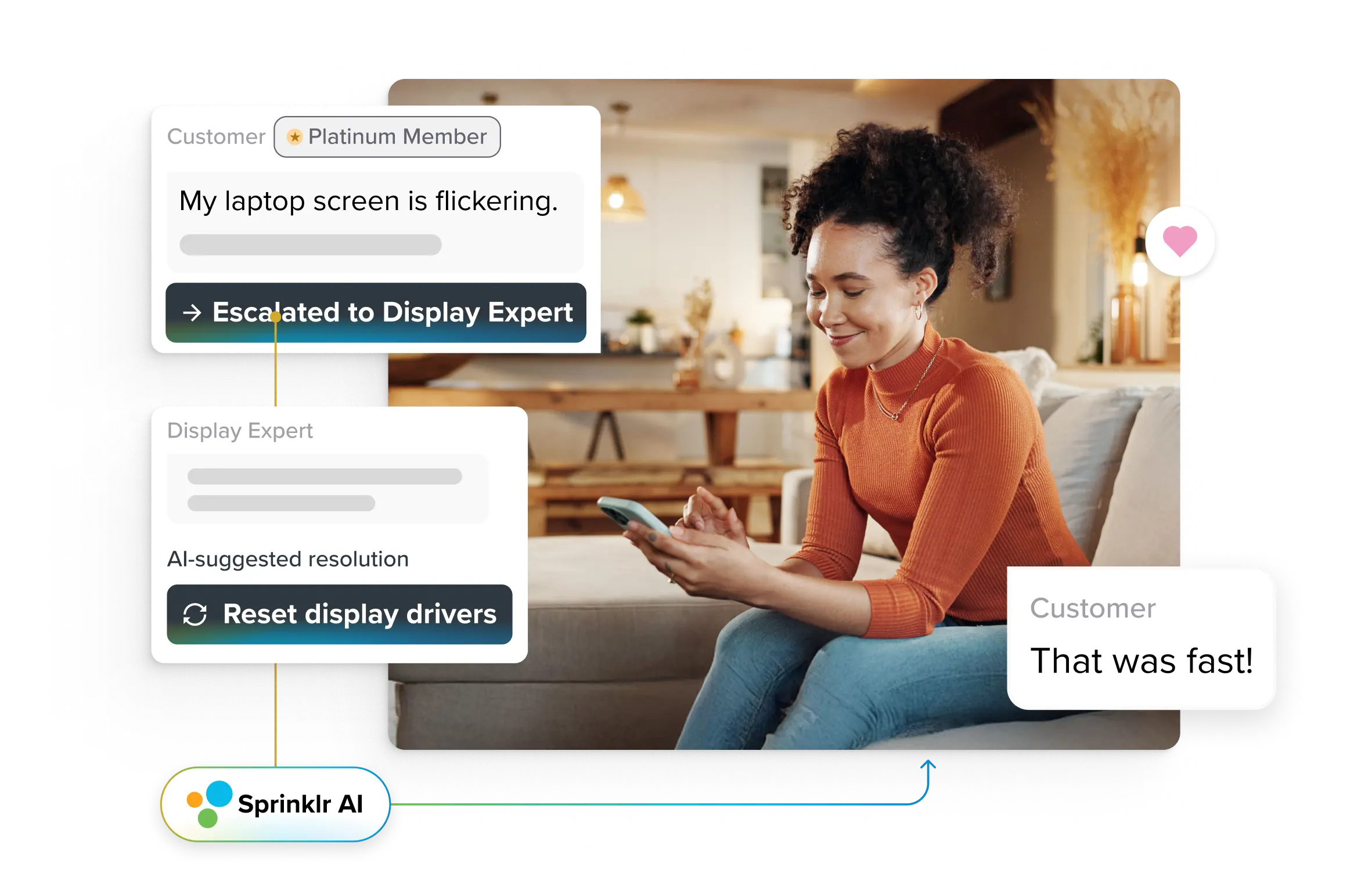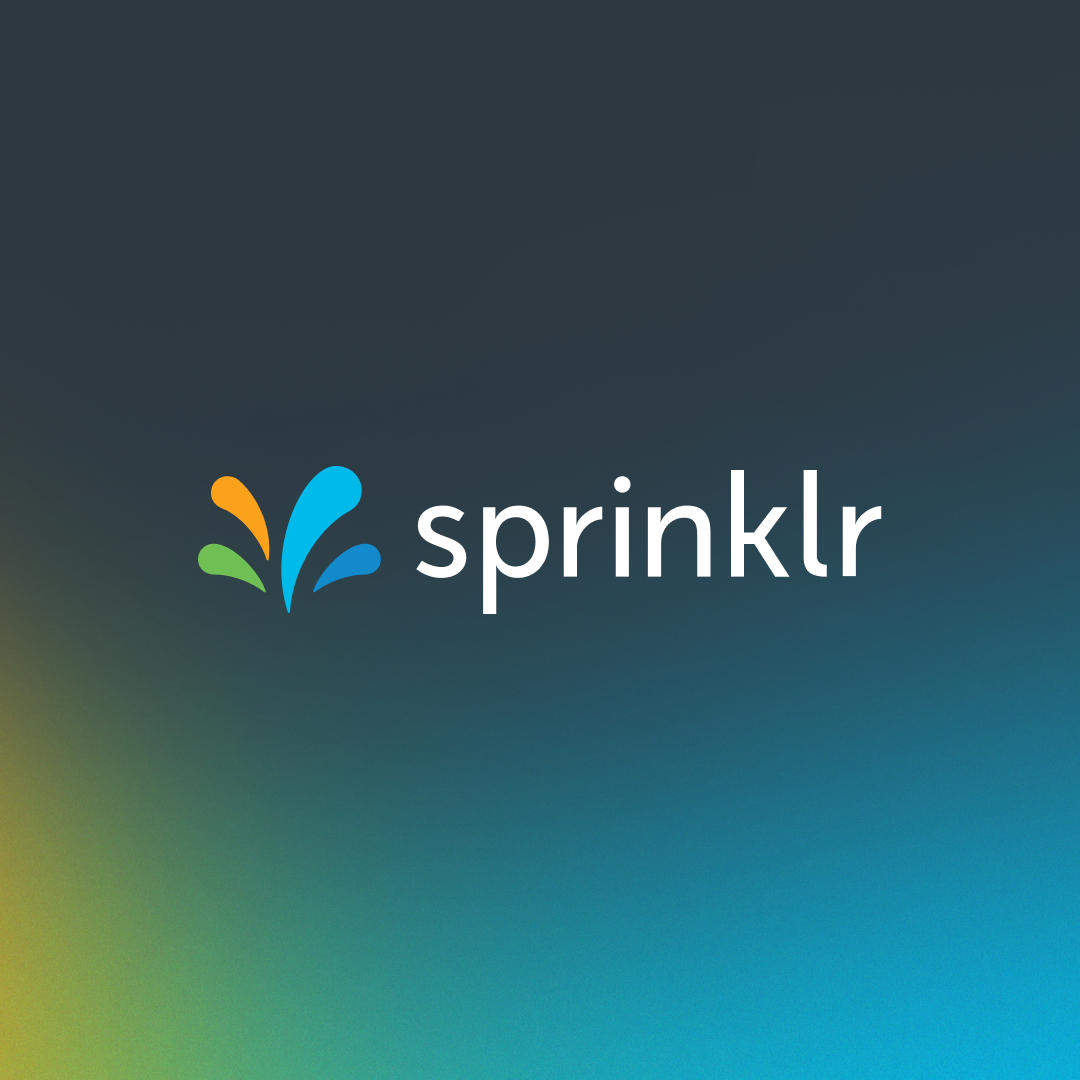Transform CX with AI at the core of every interaction
Unify fragmented interactions across 30+ voice, social and digital channels with an AI-native customer experience platform. Deliver consistent, extraordinary brand experiences at scale.

Top 30 Customer Satisfaction Survey Questions and Tips
Customer satisfaction surveys are everywhere.
From old-school paper formats and IVR calls to modern SMS links, website pop-ups and app notifications, you’ve likely encountered one in every corner of the customer journey.
But here’s the catch: not every survey does its job well. Crafting effective customer satisfaction survey questions is about asking the right questions at the right time, in the right way.
The key lies in the details:
- How do you construct the questions
- The timing of your survey
- The length of the questionnaire
Sometimes, a concise, five-question survey can uncover more actionable insights than a multi-page questionnaire ever could.
In this blog, we’ll guide you through everything you need to know:
- What are customer satisfaction surveys and why do they matter
- The top survey questions you should ask to reveal your customers’ pain points and unmet needs
- Tips and best practices to follow while creating these questions
To make things easier, we’ve categorized these questions for practical application. Let’s dive in!
What is a customer satisfaction survey?
A customer satisfaction survey is a tool businesses use to measure how happy customers are with their products, services or overall experience. It’s a set of questions designed to gather honest feedback, helping you understand what’s working and where to improve.
According to a study, 80% of customer service organizations use CSAT as the primary customer service metric to gauge and improve customer experience. Well-structured customer satisfaction surveys let you identify key issues before they snowball and make improvements if needed.
Customer satisfaction surveys are usually conducted through online forms, email marketing questionnaires or even phone calls, making it easy for customers to share their thoughts.
Key metrics involved in CSAT surveys
Customer satisfaction surveys rely on key metrics to capture and measure customer sentiment. Here are four essential ones you should know about:
✅ Customer satisfaction score (CSAT)
CSAT measures overall satisfaction by asking customers to rate their experience, typically on a scale of 1 to 5. A straightforward question like, “How satisfied were you with our service?” helps generate an average score for quick insights. It’s a go-to metric for identifying general customer satisfaction levels and addressing immediate issues.
✅ Net promoter score (NPS)
Net promoter score focuses on customer loyalty by asking, “How likely are you to recommend us to others?” Customers respond on a scale from 0 to 10, with scores divided into:
- Promoters (9-10): Loyal enthusiasts who drive referrals.
- Passives (7-8): Satisfied but not enthusiastic customers.
- Detractors (0-6): Unhappy customers who may harm your brand reputation.
The NPS is calculated by subtracting the percentage of detractors from promoters, providing a clear picture of your brand’s advocacy strength. Read How to Improve the Net Promoter Score of Your Brand
✅ Customer effort score (CES)
Customer effort score evaluates how easily a customer can achieve a resolution or service. A typical question might be, “How easy was it to resolve your issue?” Responses range from “very difficult” to “very easy.” A high CES score indicates that your processes are smooth and customer-friendly, minimizing friction in the customer journey.
Importance of customer satisfaction surveys
Customer satisfaction surveys are essential to maintaining strong customer relations. Here are four key benefits, along with real-world examples and supporting metrics.
1. Monitoring customer experience
Customer satisfaction surveys help track trends in customer experience, enabling you to identify and address issues before they escalate.
For example, Marriott Hotels collects guest preferences, enabling personalized services across their properties. By acting swiftly on customer feedback, Marriott has built a reputation for exceptional guest loyalty.
📕Related read: Tips to provide a positive customer experience
2. Improving customer satisfaction
With 89% of businesses competing primarily on customer experience, it’s clear that survey insights are essential for improving satisfaction. By revealing what matters most to customers, surveys allow you to make data-driven improvements.
For instance, Tesla actively gathers user feedback to refine vehicle features and address potential issues. This commitment to listening to customers contributes to its strong customer satisfaction scores.
3. Enhancing service quality
Customer feedback is a powerful tool for refining service processes. When used effectively, it can elevate the quality of service delivery. For instance, Southwest Airlines uses surveys to enhance customer support and streamline flight operations, continually improving on-time performance and passenger comfort.
4. Boosting overall business performance
Did you know the likelihood of selling to an existing customer is 60-70%, compared to just 5-20% for new customers? This underscores the importance of customer retention.
Customer satisfaction surveys are critical in retaining customers by driving actionable improvements. Netflix, for instance, uses user feedback to fine-tune its content recommendation engine, improving viewer retention and overall customer satisfaction.
📑 Good Read: Happy customers buy more
30 customer survey questions with examples for enterprises
Customer satisfaction surveys can give you powerful insights into your customers’ needs. To help you ask the right questions, we’ve created a list of 30 survey questions tailored for enterprises.
Each CSAT survey question is designed to gather meaningful feedback and make improvements when needed. To simplify it, we’ve divided these customer satisfaction survey questions into categories so you can come back and easily find what you need!
😊 Customer general satisfaction
Kick off your customer survey with questions that measure overall satisfaction and brand loyalty. These questions help uncover what resonates with customers and where you might need to make changes:
- On a scale of 1 to 5, how satisfied are you with our product/service?
- What did you like most about your experience with us?
- What could we do to improve your experience?
- How likely are you to return to us for future needs?
- Would you recommend our product/service to others?
Keep these questions concise and neutral to encourage honest responses. Avoid leading phrases like “Do you agree our service is excellent?”
Pro Tip: To gauge overall sentiment creatively, try running a social media poll with this question:
“What words would you use to describe our brand in one sentence?”
The responses might surprise you and offer valuable insights! 😄
👥 Interaction-specific survey questions
Tailor these questions to specific interactions to gather precise feedback on customer support experiences and resolution quality. These insights can help you refine your processes and enhance customer satisfaction.
6. On a scale of 1-5, how would you rate your interaction with our customer support representative?
7. Was your issue resolved during this interaction?
8. How easy was it to get the help you needed?
9. How would you rate the follow-up on your last support ticket or inquiry?
10. Do you feel connected to the right team member when reaching out for support? Why or why not?
These questions are most effective when sent immediately after a customer interaction, such as a call, live chat or support ticket closure. Timely surveys ensure responses are fresh and accurate, leading to actionable insights.
Pro Tip: Include an optional open-text field like: “If there’s one thing we could improve about this interaction, what would it be?”
This gives customers a chance to share more detailed feedback that might not fit into pre-set options.
🎁 Product and usability feedback survey questions
Product and usability feedback survey questions are essential for understanding how customers engage with your offerings. These insights help you identify strengths, areas for improvement and potential gaps in your product/service.
11.How would you rate the quality of our product/service?
12. Is our product/service meeting your expectations?
13. What feature of our product/service do you find most valuable?
14. Are there any features you feel are missing?
15. How does our product/service compare to competitors you’ve tried?
🎯 Best practices
- Address gaps in engagement: For customers who respond negatively or exhibit low engagement, follow up with educational content, such as guides, tutorials or webinars, to help them maximize your product’s value.
- Encourage user stories: Include a question like: “Have you used our product/service to solve a unique problem? If so, please share how.”
Leverage these user stories in community forums or promote them on social media to build trust and highlight your product's reliability.
💡 Pro Tip: Regularly analyze responses to identify recurring patterns. For example, if multiple users mention a missing feature, consider adding it to your development pipeline. Engaging with customers about such updates reinforces their value to your business.
📲 User experience (UX) and accessibility
User experience and accessibility questions focus on evaluating how intuitive, user-friendly and inclusive your platforms or services are. The feedback collected here can drive meaningful improvements for your product, design and development teams.
16. How easy was it to navigate our website/app?
17. Did you encounter any issues while using our product/service?
18. Were you able to complete your intended task on our platform?
19. On a scale of 1 to 10, how visually appealing do you find our interface?
20. Do you feel our platform accommodates your accessibility needs?
🎯 Best practices
✅ Address accessibility needs proactively: Add a comment box after Question 20 to gather specifics about unmet accessibility requirements.
✅ Utilize feedback for iterative design: Responses to these questions should feed directly into your UX/UI roadmap, prioritizing fixes and updates that enhance accessibility and navigation.
✅ A/B test visual and functional changes: Before implementing significant changes based on feedback, conduct A/B tests to ensure the proposed solutions resonate with a broader audience.
💝 Customer loyalty and retention
Customer loyalty and retention surveys aim to uncover the factors driving repeat business and ongoing relationships with your brand. These insights are critical for shaping customer retention strategies and improving long-term customer satisfaction.
21. How likely are you to continue using our product/service in the future?
22. What was the primary reason for choosing us over competitors?
23. Have you ever considered switching to a competitor? If so, why?
24. What keeps you coming back to us?
25. What improvements would make you more likely to stay with us?
💡 Pro Tip: Pair loyalty-related questions with small incentives, such as discount codes, free trials or loyalty program perks. This approach increases response rates and reinforces customer goodwill and brand loyalty.
🤩 Brand perception
In an increasingly competitive landscape, understanding how your brand is perceived by customers is crucial. Brand perception surveys help identify strengths, areas for improvement and opportunities to differentiate yourself in the market.
26. What three words would you use to describe our brand?
27. Do you feel our brand aligns with your values?
28. How does our brand make you feel?
29. What differentiates our brand from competitors in your opinion?
30. Would you consider our brand trustworthy?
💰 Two cents from Sprinklr
Understanding how customers perceive your brand is only half the battle — acting on those insights drives meaningful change. While traditional surveys gather feedback, they often fall short of delivering actionable consumer insights or uncovering hidden trends.
Sprinklr Surveys, powered by Sprinklr AI+, transforms this process by providing direct, actionable insights with clear explanations of what happened and why. Its advanced AI capabilities proactively detect emerging customer experience drivers and conversation themes, helping you stay ahead of evolving expectations.
With minimal setup, Sprinklr Surveys streamlines feedback collection and empowers you to make impactful, real-time improvements that truly resonate with your customers.

Before we head to the top tips section...
Demographic information is essential in customer surveys as it provides the context behind the feedback you receive. Understanding who your customers are enables you to:
- Personalize customer experiences: Tailor products, services and marketing messages to meet specific customer needs and preferences.
- Segment audiences effectively: Group customers based on shared characteristics to deliver targeted solutions and campaigns. Read more about audience segmentation
- Identify market trends: Analyze trends within specific demographics to spot opportunities for growth or address emerging challenges.
- Improve decision-making: Combine demographic data with survey responses for more informed, strategic business decisions.
- Enhance product development: Understand which demographics value particular features or services, guiding future innovations.
For instance, a retail brand might find millennials prefer mobile-first shopping experiences, while Gen Xers value in-store interactions. This insight can inform everything from platform investments to customer service training.
Here’s a breakdown of key demographic data points businesses should consider:
1. Age Group
Why: Helps identify generational preferences and behavior patterns.
Question: Which age group do you fall into? (e.g., 18-24, 25-34, 35-44)
2. Gender
Why: Aids in understanding purchasing behaviors and preferences that may differ by gender.
Question: What is your gender? (Male, Female, Non-binary, Prefer not to say)
3. Location
Why: Geographic insights enable regional targeting and localization efforts.
Question: Where are you located? (City, State, Country)
4. Income Level
Why: Indicates spending capacity and helps position premium vs. budget offerings.
Question: What is your annual household income? (e.g., <$50K, $50K-$100K, >$100K)
5. Education Level
Why: Influences preferences for communication style and product complexity.
Question: What is your highest level of education? (e.g., High school, Bachelor’s, Master’s, PhD)
6. Occupation/Industry
Why: Helps tailor products/services for specific professional needs.
Question: What is your occupation/industry?
7. Marital/Family Status
Why: Offers insights into lifestyle preferences, such as family-friendly offerings.
Question: What is your marital status? (Single, Married, Domestic partnership, etc.)
8. Preferences or Interests
Why: Complements demographic data by adding psychographic insights.
Question: What are your primary interests? (e.g., Fitness, Technology, Travel)
Tips to build a good client satisfaction survey questionnaire
Creating an effective client satisfaction survey is essential for gathering valuable feedback. Here are four tips to help you craft a solid questionnaire.
📝 Use clear and restrictive options
When designing your survey, use clear and specific options for responses. This helps eliminate confusion and allows customers to express their opinions accurately. For instance, instead of asking, “How was your experience?” consider options like “Excellent,” “Good,” “Fair” or “Poor.” This clarity helps you gather more actionable insights.
⚡ Require a response to every question
To ensure you collect comprehensive data, ask for responses to all questions. This encourages participants to think carefully about their answers and reduces incomplete surveys. You can use mandatory response settings in online survey tools to enforce this, leading to more robust results.
⏳ Avoid too many questions
Limit the number of questions in your survey to keep it concise. A shorter survey is more likely to be completed, as customers appreciate efficiency. Aim for 5-10 questions that focus on key aspects of your customers’ experience. This approach respects your customers’ time and increases the likelihood of receiving thoughtful responses.
💬 Attach opinions to questions
When framing your questions, encourage customers to share their opinions. Instead of simply asking for ratings, include open-ended questions like, “What did you like most about our service?” or “How can we improve?” This allows for richer feedback and insights that quantitative questions alone may miss.
Curated for You: Top 11 Customer Feedback Tools for Customer Service in 2024
Turn routine feedback collection into meaningful conversations
Sending out customer satisfaction surveys is no longer enough. If your current survey software is failing to deliver the results you need — whether it’s low response rates, limited insights or poor engagement — Sprinklr Survey software has the solution you've been looking for.
Sprinklr’s AI-powered conversational surveys revolutionize the feedback experience by:
- Driving higher completion rates: Engage customers with interactive surveys that feel more like a dialogue than a traditional questionnaire.
- Uncovering richer insights: Leverage AI to dynamically tailor follow-up questions based on previous answers, allowing you to dig deeper into customer sentiment and needs.
- Enhancing survey experiences: Use visually appealing, customizable designs that encourage participation and integrate seamlessly into the customer journey.
Curious to see it in action? Schedule a demo with our experts today and transform the way you gather and act on customer feedback.
Frequently Asked Questions
The ideal length for a customer satisfaction survey is usually between 5 to 10 questions. This allows respondents to provide thoughtful feedback without feeling overwhelmed or losing interest, which can lead to higher response rates.
Contact centers can increase response rates by keeping surveys short, offering incentives and sending reminders. Additionally, timing the survey to follow immediately after customer interactions can significantly boost engagement.
To design effective questions, businesses should focus on clarity and relevance. Mixing question types, such as rating scales and open-ended questions, helps gather diverse insights and ensures that each question addresses a specific aspect of the customer experience.
Common mistakes include using ambiguous or leading questions, making surveys too lengthy and failing to pilot-test the survey. Avoiding jargon and ensuring questions are directly related to the customer experience is crucial for obtaining accurate feedback.
Contact centers can tailor surveys by analyzing customer data to identify segments based on demographics, purchase behavior or interaction types. This allows them to customize questions that resonate with each group’s unique experiences and needs.










